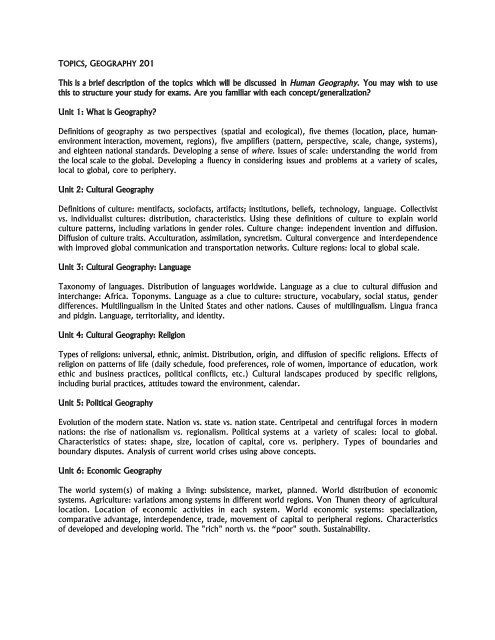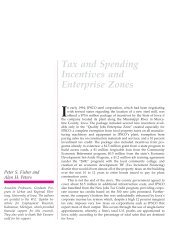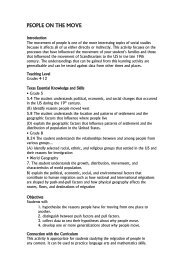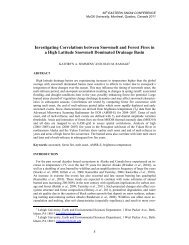Download Course Description
Download Course Description
Download Course Description
Create successful ePaper yourself
Turn your PDF publications into a flip-book with our unique Google optimized e-Paper software.
TOPICS, GEOGRAPHY 201<br />
This is a brief description of the topics which will be discussed in Human Geography. You may wish to use<br />
this to structure your study for exams. Are you familiar with each concept/generalization?<br />
Unit 1: What is Geography?<br />
Definitions of geography as two perspectives (spatial and ecological), five themes (location, place, humanenvironment<br />
interaction, movement, regions), five amplifiers (pattern, perspective, scale, change, systems),<br />
and eighteen national standards. Developing a sense of where. Issues of scale: understanding the world from<br />
the local scale to the global. Developing a fluency in considering issues and problems at a variety of scales,<br />
local to global, core to periphery.<br />
Unit 2: Cultural Geography<br />
Definitions of culture: mentifacts, sociofacts, artifacts; institutions, beliefs, technology, language. Collectivist<br />
vs. individualist cultures: distribution, characteristics. Using these definitions of culture to explain world<br />
culture patterns, including variations in gender roles. Culture change: independent invention and diffusion.<br />
Diffusion of culture traits. Acculturation, assimilation, syncretism. Cultural convergence and interdependence<br />
with improved global communication and transportation networks. Culture regions: local to global scale.<br />
Unit 3: Cultural Geography: Language<br />
Taxonomy of languages. Distribution of languages worldwide. Language as a clue to cultural diffusion and<br />
interchange: Africa. Toponyms. Language as a clue to culture: structure, vocabulary, social status, gender<br />
differences. Multilingualism in the United States and other nations. Causes of multilingualism. Lingua franca<br />
and pidgin. Language, territoriality, and identity.<br />
Unit 4: Cultural Geography: Religion<br />
Types of religions: universal, ethnic, animist. Distribution, origin, and diffusion of specific religions. Effects of<br />
religion on patterns of life (daily schedule, food preferences, role of women, importance of education, work<br />
ethic and business practices, political conflicts, etc.) Cultural landscapes produced by specific religions,<br />
including burial practices, attitudes toward the environment, calendar.<br />
Unit 5: Political Geography<br />
Evolution of the modern state. Nation vs. state vs. nation state. Centripetal and centrifugal forces in modern<br />
nations: the rise of nationalism vs. regionalism. Political systems at a variety of scales: local to global.<br />
Characteristics of states: shape, size, location of capital, core vs. periphery. Types of boundaries and<br />
boundary disputes. Analysis of current world crises using above concepts.<br />
Unit 6: Economic Geography<br />
The world system(s) of making a living: subsistence, market, planned. World distribution of economic<br />
systems. Agriculture: variations among systems in different world regions. Von Thunen theory of agricultural<br />
location. Location of economic activities in each system. World economic systems: specialization,<br />
comparative advantage, interdependence, trade, movement of capital to peripheral regions. Characteristics<br />
of developed and developing world. The "rich" north vs. the “poor" south. Sustainability.
Unit 7: Population Geography<br />
Basic concepts of population: distribution, density, growth rate, interpreting population pyramids. Historical<br />
patterns in population growth: the J curve and the S curve. Demographic transition: will it predict future<br />
patterns of population growth? Factors which affect population growth in the developing world: the Cycle of<br />
Doom. Gender roles and world population growth.<br />
Unit 8: Migration<br />
Migration as an enduring theme of human history: migrations in ancient times, the historical past, and the<br />
present. Migration at a variety of scales: local, regional, and international. Types of migrations. Patterns of<br />
migration: step migration, chain migration, channeled migration. Role of distance decay and information flow<br />
in migration patterns. Barriers to migration; inducements to migration. How is the decision to migrate made?<br />
Push and pull factors, voluntary and involuntary migration. Rules of migration: who, what, when, and why.<br />
Unit 9: Urban Geography<br />
What is a city?: functions and purposes. Land value and urban growth in the United States. Systems of cities<br />
and central place theory: threshold and range. World patterns in urban growth: links between economic<br />
development and urbanization. World urban morphology: diversity in the United States, Europe, South<br />
America, Africa, and Asia. The primate city vs. rank size rule. Social areas in North American cities.<br />
Unit 10: Human Impact on the Environment<br />
Interaction of human systems and physical systems. Ways humans adapt to, modify, and use the<br />
environment. Issues of pollution, resource use and management in the developed and developing world.<br />
Perceptions of natural hazards at a variety of scales. Cultural reactions to hazards: planning for disaster in<br />
Japan vs. So. California. Variations in world patterns of technology and consequent effects on environment.<br />
Global solutions to global problems: climate change, ozone depletion, land degradation.
















